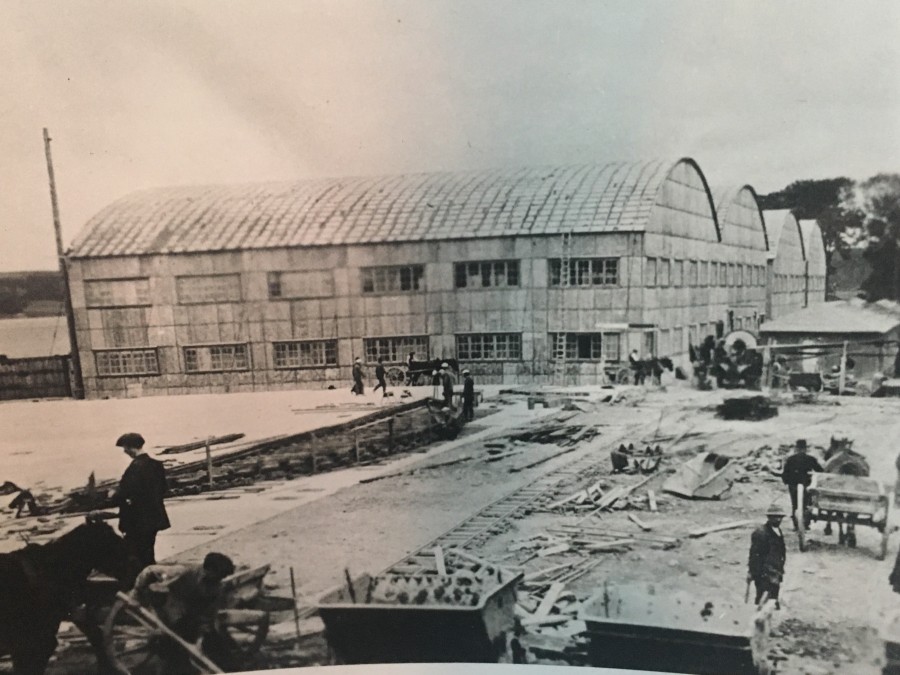
Kieran’s Our City, Our Town Article,
Cork Independent, 13 December 2018
Stories from 1918: The Leaving of the American Navy
“On a very fine early summer afternoon in 1917 the Americans first entered the harbour in connection with the great war now ended. Their coming, except to the official few, was almost unknown until an hour or so before their actual arrival in port. From their first landing at Queenstown, they were gladly welcomed by its inhabitants, and their presence gave an added stimulus to an already prosperous war-trade being done in the town”. Queenstown Correspondent, Cork Examiner, 6 December 1918.
Immediately following the declaration of war by the USA on 6 April,1917, a force of destroyers of the US Navy set sail for Cork Harbour, arriving there on 4 May. At that time, the Naval Aviation Command was still in its infancy and not quite prepared for the task ahead. With rigid and untiring discipline, they were regularly viewed taking on the stormy waters of the Atlantic beyond Cork harbour. They treated unfortunate men, women and children who were victims of torpedo, collision, storm or mine. Many found safety on American destroyers.
The force based in Queenstown (now Cobh) consisted of 1200-ton sloops with trawlers, drifters, destroyers, motor launches and submarines, to which were later added minesweepers and disguised armed merchant ships known as ‘Q’ (for Queenstown) ships. The lower harbour area could be illuminated at night using searchlights located at all of the forts. From the beginning, the Americans built facilities for discharging and storing their inbound cargo. A railway sprang into being on the hitherto neglected Deepwater Quay, a store-house quickly covered a portion of its surface.
To mark this physical legacy and others, Cork County Council creating a trail setting out a number of key locations within the Harbour chosen for the role they played during the First World War. The development of the trail is due to the vision of the late Cllr Claire Cullinane who was a great advocate for the heritage potential of the whole of Cork Harbour and who initially proposed the trail.
During 1918, reference is made in the press to the American Navy presence in Cork Harbour. For example, on 4 July 1918 at Queenstown, the Stars and Stripes flew from many buildings and flagstaffs, and at Haulbowline Dockyard the American flag flew with the British. Shops were closed during the day and large numbers attended sports specially organised at Aghada and Ringaskiddy. In the evening a concert in the Bathe Hall, which was largely attended by officers of the American and British Navies.
On 25 July 1918, the First Lord of the British Admiralty, Sir Eric Geddes and Mr Franklin Roosevelt, arrived in Cork. Roosevelt, later to be President of the United States was Assistant Secretary of the Navy under President Woodrow Wilson during the First World War. Sir Eric Geddes went on a tour of inspection in the South of Ireland. He paid a visit to the Government Dockyard at Haulbowline and visited the US store ship Melville and the US air station at Aghada.
A total of twenty-five air stations were established throughout Europe, five of which were to be in Ireland. All the Navy’s seaplanes were shipped to Ireland in crates and taken to Aghada for assembly before delivery to their assigned stations. Aghada also became the main training base where all aircrew training was conducted. A further vital role for Aghada was as a patrol base, searching for German U-boats from Cape Clear eastwards into St George’s Channel. But some thirteen weeks after the first flight out of Aghada, the Armistice was signed on 11 November 1918, bringing patrols to an end. Production of aircraft, which had peaked at one completed every 3 days, came to a halt and the forty-eight officers and1,398 men began leaving Aghada.
In 1921 the 3 ½ -acre site of the old World War I American Air Base was purchased by the Lower Aghada Tennis and Sailing Club for the princely sum of £5 from the Land Commission. The club originally played in the Careystown area. Ten people from the area each contributed 10/- (50p) each, and two trustees, Messrs. Terence Murphy, NT and Edmund Russell. The actual playing surface was on the remains of the old runways.
On 5 August 1918, thirteen American Congressmen on a visit to the United Kingdom arrived at Kingstown (now Dun Laoghaire and then travelled by special saloon direct to Queenstown. They were members of the Committee of Naval Forces of the House of Representatives They were coming to Cork to see the activities of the U.S. Navy overseas and of the Allied Navies. In an interview Congressman Mr. Padgett from Tennessee noted that that during the month of July they had brought 317,000 troops to Europe and that was the high-water mark. Month by month they were continuing to bring soldiers over as rapidly as possible. America, he concluded, was determined “to go on to the end and win”.
When the Armistice was put in place on 11 November 1918, the Queenstown Correspondent for the Cork Examiner on 6 December 1918 noted: “To each and every departing member of the United States Navy based at Queenstown during the war, quarterdeck and lower deck alike, its inhabitants bid God speed and bon voyage”.
Kieran’s new book, Cork in Fifty Buildings (2018, Amberley Publishing) is now available in Cork bookshops.
Kieran is also showcasing some of the older column series on the River Lee on his heritage facebook page at the moment, Cork Our City, Our Town.
Captions:
976a. American Air Base, Aghada, c.1918 (source: Aghada Historical Society & Cork Harbour Heritage Alliance)
976b. American Air Base, Aghada, County Cork, c.1918 (source: Aghada Historical Society & Cork Harbour Heritage Alliance
